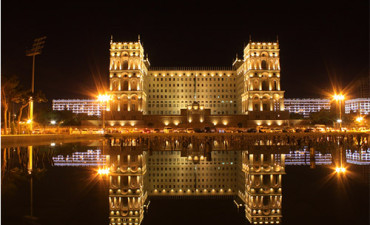Old City – Inner City
Baku Old Town (also Baku Old City or Inner City) is the biggest historical attraction in Baku. Fortress walls surround the Old Town. Being classified as a World Heritage Site by UNESCO, the Old Town is not only a bunch of ancient stones, but it is a lively area with about 3000 inhabitants.
History of the Old Town
From the first century BC, Baku was already a small, but perfect port city. In the VIII-IX centuries, crafts and trade developed in the Icheri Sheher.
During Shirvanshah’s rule, many construction works are being carried out in Baku and the city was developing. In the twelfth century, the city’s defense system was strengthened by building fortress walls.
After the end of the 19th and early 20th century, the city was expanding after the oil boom, and people began to dwell in the outside of Icheri Sheher. The concept of “Icheri Sheher” only appears after the formation of the outer city.
Many monuments were constructed in Baku during the period between 11th and 16th centuries. The Sinig Gala Minaret, the Maiden Tower, the Multani and Bukhara Caravanserais, the Haji Gayyib and Gasimbey bathhouses, the Palace of Shirvanshahs, as well as the fortress walls and towers are among those.
During the Russo-Persian War (1804 – 1813), the Russian Empire occupied Baku, the city with 7 thousand inhabitants. There were 500 households and 707 shops in the Old Town, which was the only neighborhood of the city. In this period, Baku began to expand beyond the city walls and thus new neighborhoods appeared.
With the beginning of the rule of Russian Empire in 19th century and early 20th century, traditional oriental architecture has changed. Many European buildings were constructed using styles such as Baroque and Gothic.
List of the historical monuments of Baku Old City
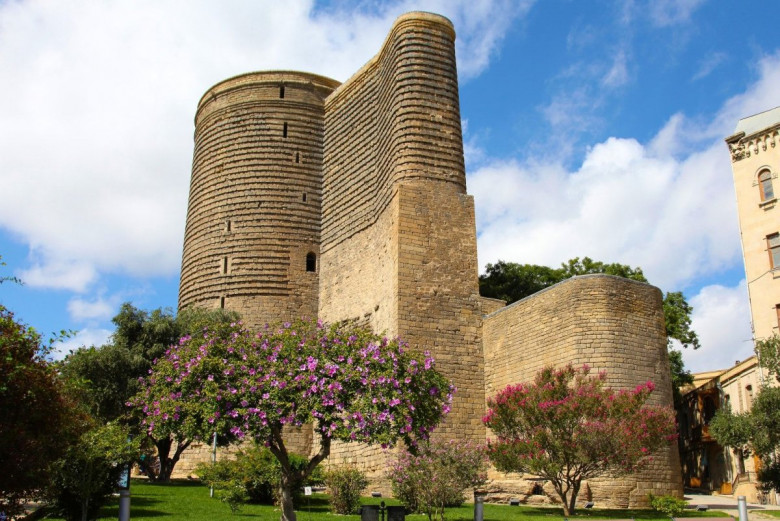
Maiden Tower
Baku’s Maiden Tower is a legendary place and world-famous landmark in Baku, Republic of Azerbaijan. The Tower is covered by cloud of mysteries and legends which are rooted to the History of Azerbaijan and national Culture of Azerbaijan. The pool of tower’s epics and legends is a part of Azerbaijan’s culture and national heritage. The Maiden Tower is a 12th-century monument in the Old City, Baku, Azerbaijan. Along with the Shirvanshahs’ Palace, dated to the 15th century, it forms a group of historic monuments listed in 2001 under the UNESCO World Heritage List of Historical Monuments as cultural property, Category III. It is one of Azerbaijan’s most distinctive national emblems, and is thus featured on Azeri currency notes and official letterheads.
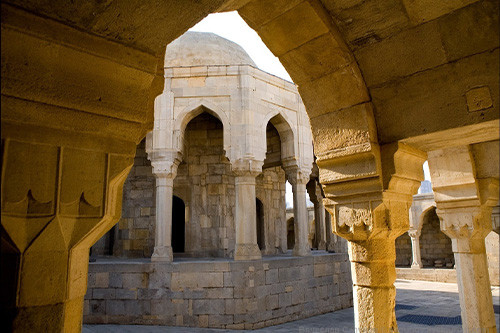
The Palace of the Shirvanshahs
The Palace of the Shirvanshahs is a 15th-century palace built by the Shirvanshahs and described by UNESCO as “one of the pearls of Azerbaijan’s architecture”. It is located in the Inner City of Baku, Azerbaijan and, together with the Maiden Tower, forms an ensemble of historic monuments inscribed under the UNESCO World Heritage List of Historical Monuments. The complex contains the main building of the palace, Divanhane, the burial-vaults, the shah’s mosque with a minaret, Seyid Yahya Bakuvi’s mausoleum (the so-called “mausoleum of the dervish”), south of the palace, a portal in the east, Murad’s gate, a reservoir and the remnants of a bath house. Earlier, there was an ancient mosque, next to the mausoleum. There are still ruins of the bath and the lamb, belong to the west of the tomb.

Bukhara Caravanserai
Bukhara Caravanserai was erected in the late 15th century over a trade route passing through the Shamakhi Gates of the fortress. It is close to the Maiden Tower. The caravanserai was harnessed as a hotel, basically catering to merchants of Central Asia.
The shape of the caravanserai building is square and surrounded by balconies and cells, and the portal is convex. The caravanserai has an octagonal courtyard as well as. The bulk of the architectural composition of the caravanserai has been formed by a variety of arches situated around the inner courtyard.

Multani Caravanserai
Multani Caravanserai was established in the 14th century. It is opposite to the Bukhara Caravanserai.
Now Multan is the name of the city in Pakistan. The merchants and Zoroastrians from India harnessed this caravanserai as a stop. It is assumed that these people erected the Ateshgah Temple of Zoroastrians in Surakhani.
The caravanserai has a square shape and the constructions of the building is in an ancient style. There are a lot of balconies around the courtyard. Now the Multani Caravanserai houses a restaurant of Azerbaijani cuisine.
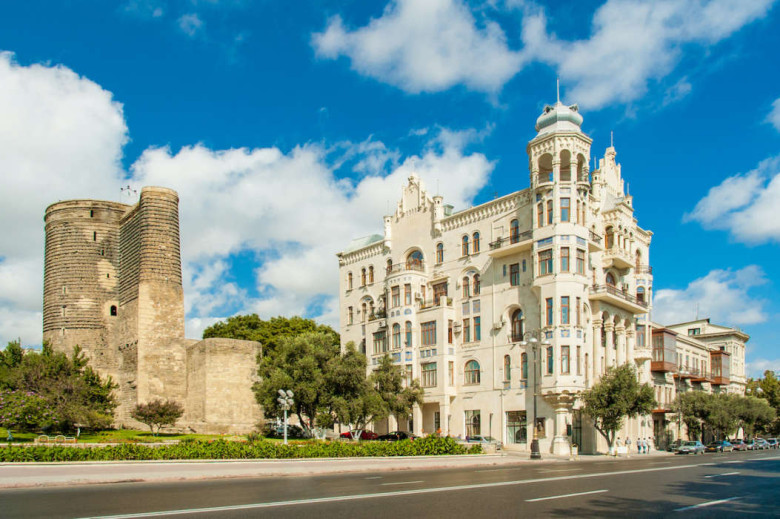
Isa bey Hajinski’s Palace
he Isa Bey Hajinski Palace, which survived the period of rapid prosperity, met with the aggressive fury of the Dashnaks and Bolsheviks and endured total nationalisation, absorbed the whole turbulent history of the past century. In November 1944 during the Second World War, General De Gaulle stayed in the Hajinski House on the way from Tehran to Moscow and in a later period the same apartment was inhabited by the family of the outstanding scientist and chemist and twice President of the National Academy of Sciences of Azerbaijan Yusif Heydar oghlu Mammadaliyev, whose hundredth anniversary was formally celebrated by UNESCO in 2005.
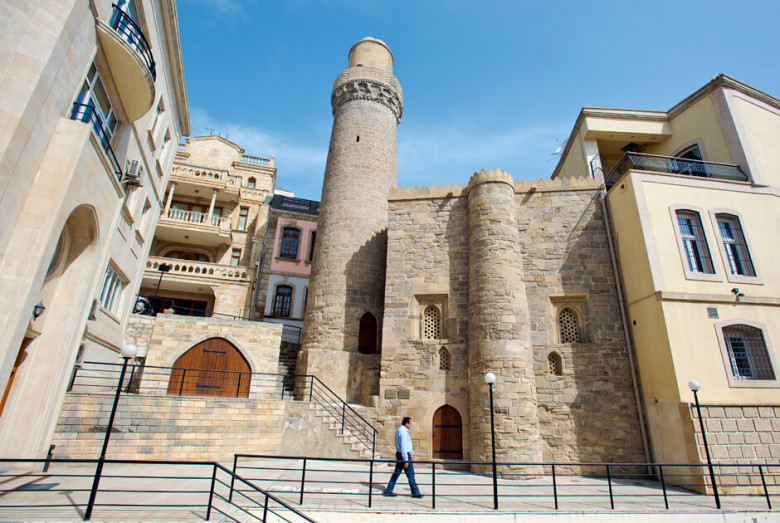
Sinig Gala Minaret

Juma Mosque
Juma Mosque is a mosque in Baku, Azerbaijan. The Cathedral Mosque was built in the 12th century on the site of a temple of fire-worshipers.
There is an inscription on the mosque emphasize that “Amir Sharaf al-Din Mahmud ordered to restore this mosque in the month of Rajab 709 A.H. (1309)”. On the northern wall of the mosque a minaret was erected which had been surrounded by stalactites in the year of 1437.
Located in the historic Icheri Sheher, the mosque has been rebuilt several times. The present Friday Mosque was built in 1899 under the financing of Baku philanthropist merchant Haji Shikhlali Dadashov. There are traces of a Zoroastrian temple at the site.
In the cultural life of the medieval Azerbaijan the cathedral mosque served as socio-cultural centers.
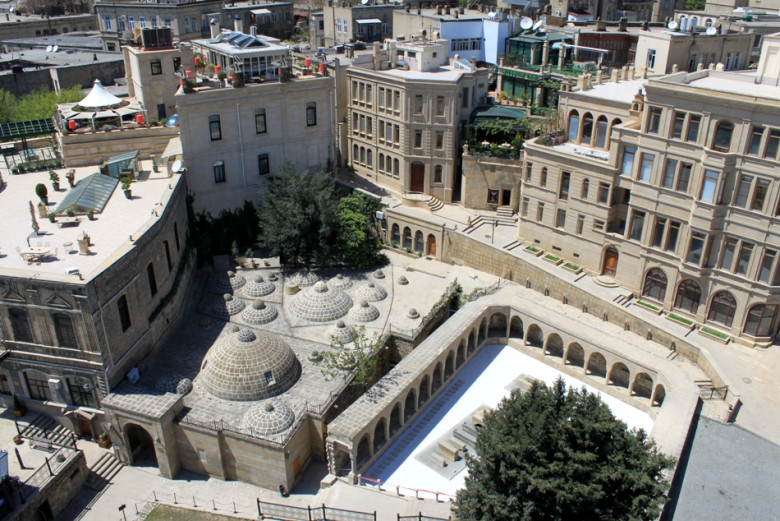
Haji Gayyib Bathhouse
Haji Gayib’s bathhouse – is an ancient fortress construction near a coastal side of Icheri Sheher.
Haji Gayib’s bathhouse is located in Baku quarter of Icheri Sheher, opposite the Maiden Tower. History of the bathhouse is dated back to the 15th century.
Intake portal of the bathhouse is rectangular shaped. Whole complex of the bathhouse is divided into 3 groups: dressing-room, changing room and a bathing area. The dressing and changing rooms have octagonal halls, surrounded by small rooms. Vaults and domes have various figured outlines and were implemented thoroughly. There is a pool with warm and cold water in the centre of the hall. Floors are covered with stone plates. Heating is promoted by ceramic pipes or channels under the floors of the rooms. Warm air, produced by water heating circulates along these channels.
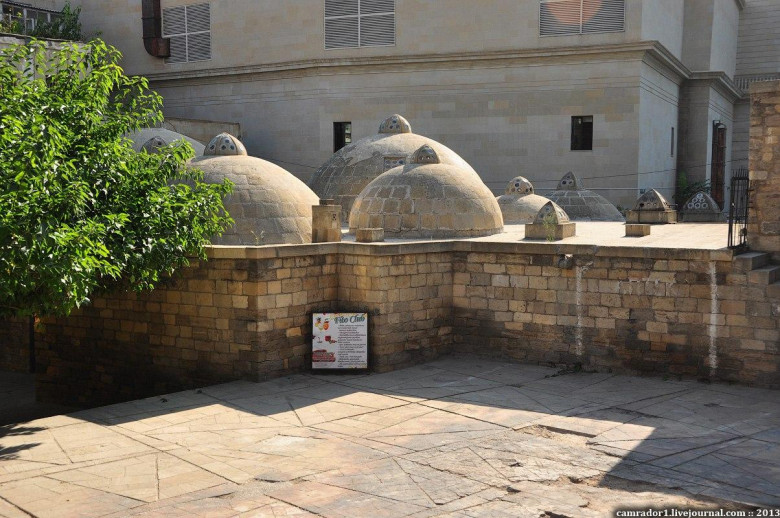
Gasimbey Bathhouse
The Gasim bey Bath, built in the 17th century, is a medieval monument of national importance. Also named Sweet Bath for the sweets served to bathers with their tea, it is located near the Salyan gates of the fortress, Icheri Sheher, Azerbaijan.
The bath has a traditional design, with an entrance hall, a cloakroom, baths, swimming pools and a boiler-house. Cross-shaped domes are in the dressing room and swimming pool. They were located on the sides of rooms with their chambers. Ceramic tubes were located in the walls and under the floor for supplying water and heating.
In 1970, the bath was reconstructed, and turned into a pharmacy known as the “Green Pharmacy”.
You can also read details of the Old City tour and book it here.
Tags: Baku , Azerbaijan , Maiden Tower , Old City , UNESCO , Zoroastrians , Juma Mosque , Inner city , Shirvanshah , Caravanserais , Azerbaijani cuisine , Isa bey , Gasimbey bathhouse
Recent Posts

Buy any tour and get 15 percent discount in Baku restaurants
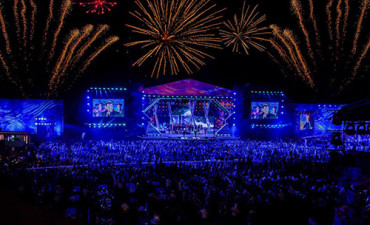
Festivals In Azerbaijan

Great Silk Road In Azerbaijan
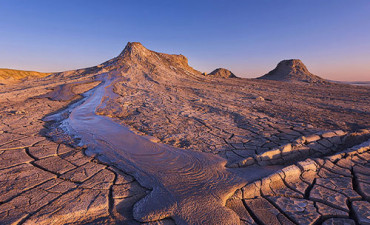
Guide to outdoor activities
